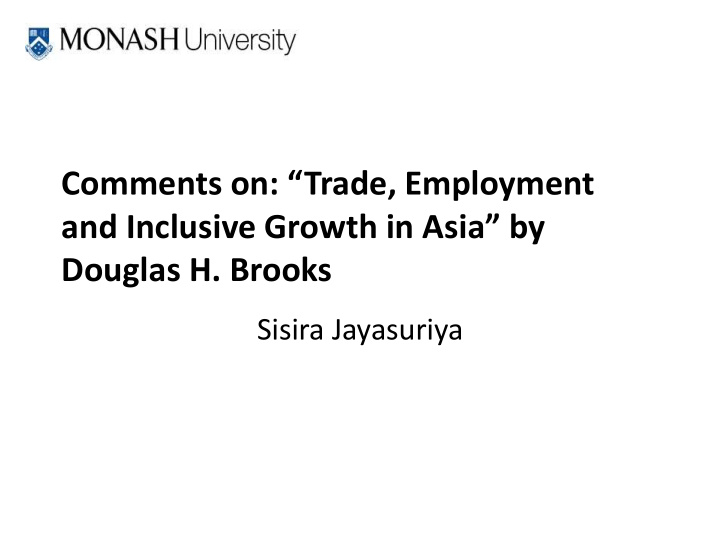



Comments on: “Trade , Employment and Inclusive Growth in Asia” by Douglas H. Brooks Sisira Jayasuriya
Asia: similarities and differences • As pointed out: – The trade-growth relationship is very strong in Asia – probably the most dramatic illustration globally. – Again similar to experience elsewhere, unskilled labour-rich Asian developing countries are experiencing growing inequality: so the simple Stolper-Samuelson proposition does not hold. – Structural changes (contracting agriculture sector), demographic changes, more educated workforce 2
Policy Issues and Research Agenda The policy and research agenda in developed countries – and academia - driven largely by concerns about job losses in traditional labour intensive industries due to trade liberalisation and off-shoring: • Major shift in research paradigm: from ‘older’ trade theory – Including, Krugman style New Trade Theory - to New-New Trade Models (Melitz – heterogeneous firms). • These models do give richer insights – Within sector labour movements: productivity/wage effects: more productive firms export, experience faster productivity growth, pay higher wages and may become more capital and skill intensive • Similar changes are happening in Asian economies: opening to global markets and FDI has made more industries tradable and shifted the boundary within industries between exporters and non-exporters BUT………………… 3
Unemployment of workers in ISI industries due to trade liberalisation no longer central issue – compared to both developed and ‘emerging’ economies - like Brazil • Asia, as a region, at a different stage of trade liberalization • Manufacturing trade liberalisation – though behind the border barriers remain important, Asia has made huge progress in trade liberalisation (in general, low average tariffs/tariff equivalents) – Employment share of ISI industries within manufacturing has greatly diminished – Sequencing and ‘by - passing’ strategy has minimized major (un) employment effects – Opening up other (labour intensive, export oriented) manufacturing sectors; development of export platforms with FDI 4
Rising Inequality: a major concern • Inequality increase suggests Stolper- Samuelson effects swamped by other factors • Scope for application of New – New Trade models – Skill-biased technology? • Plausible. Large inflows of FDI might further strengthen because of ‘skill -biased technology embodied in imported capital equipment’ 5
Large sectoral labour shifts have already occurred in many Asian countries • Contrast with most developed and many non- Asian developing regions • But cases recorded where immobility has had negative income and employment consequences – Broad Implications clear: • Facilitate sectoral, spatial and occupational labour mobility • But more policy measures and research needed to develop cost-effective, practical interventions 6
Dynamics of change and adjustment should be modeled and analyzed with more attention to the specific features of Asian countries 7
In Asia, the major areas for further opening is in segments of the services sector and (food) agriculture These are characterized by : Small firms (farms) and large informal labor force 8
Somewhat different issues…. • Impact on small farms/firms in agriculture, retail trade pose rather different issues to ‘pure’ labour market adjustment assistance • Concerns about: – food and income security – land concentration – large (possibly foreign owned) firms 9
As pointed out, 10
Globalization and the Informal Sector • Literature shows that relationships are complex,, context-dependent • Research in Asia sparse (e.g. Manning and Aswicahyono, 2012) – Sectors are very heterogeneous • Does trade – and more generally globalisation - widen the formal- informal wage gap? • If so, through what channels? – Is globalisation formal-biased, skill-biased? – Is there a size-bias? • Small producers (farms) • Supply chains and segments • What interventions? 11
More effort needed into understanding and formulating concrete adjustment policies in particular segments of services, food agriculture, paying attention to specific features such as informality 12
Thank You 13
Recommend
More recommend